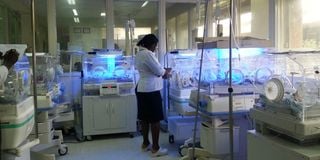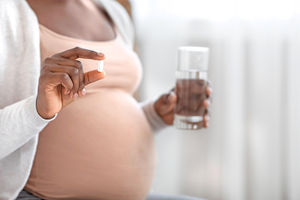Relief as scientists find way to detect pre-term births

A nurse checks on pre-term babies at Kenyatta National Hospital (KNH).
Kenyan mothers who receive antenatal care from skilled birth providers but still do not know what really causes of preterm birth can now breathe a sigh of relief.
This comes after scientists who analysed metabolic substances in the vaginal microbiome now say that there may be a way to predict the risk of premature labour.
The scientists had sought to know why spontaneous preterm birth (sPTB) is a leading cause of maternal and neonatal morbidity and mortality.
Metabolites are small substances made when drugs, foods or other chemicals in the system degrade.
Pre-term birth is the delivery of a baby before 37 weeks of gestation or less than 259 days from the mothers' report of the first day of the last menstrual period.
This means that most babies will be born between 37 – 40 weeks and these babies are referred to as ‘term babies'.
In the peer reviewed study published by Nature; a global scientific journal, the scientists y pointed out that certain metabolic substances in the vagina may predict if a baby will be born premature and this is one of the leading causes of newborn death.
“ The human microbiome is a strong biomarker of many complex diseases. The vaginal microbiome, specifically, has been repeatedly associated with sPTB and other adverse pregnancy outcomes,” the researchers observed while highlighting that metabolites produced or modified by the microbiome have emerged as a prominent factor with potential local and systemic effects on the host.
According to Mr Tal Korem and his colleagues at Columbia University in New York, they assessed 232 vaginal swab samples collected during the second trimester of pregnancy.
80 of the samples came from pregnancies ending in pre-term birth and about 75 per cent of the samples came from people who identified as Black; a group which they say is disproportionately affected by premature births.
Though other studies in the recent past have also fingered vaginal microbiome when it comes to pre-term birth, unlike what they found, this team was able to identify both the microbes and the metabolites in each sample and then this data to train machine learning models to predict whether a pregnancy would end in preterm birth.
This is after they discovered that certain metabolites, but not microbes, had the strongest association with preterm birth.
Good predictor
They further explain that they evaluated the models using a statistical measure that estimates accuracy on a scale of 0 to 1 and this means that what constitutes a good score varies and in the case of preterm birth, a score of 0.8 and above shows that the accuracy is excellent.
Their score was 0.78 and they say this shows that their model is a good predictor of preterm birth.
"Furthermore , they interestingly found many of the metabolites associated with preterm birth weren’t created by microbes or humans. “They’re coming from an external source,” Mr Korem noted while proposing more analysis to establish the source.
" Some of these metabolites, like ethyl glucoside and Ethylenediamine tetraacetic acid (EDTA) are present in certain cosmetic and hygienic products,” he noted while reminding that the findings are only an association and do not in any way prove a causal relationship.
“This is very preliminary, but we’re sort of raising a flag and saying, look, there’s something suspicious here that we need to look into,” he added.
We further found lower levels of choline in women with subsequent sPTB. Choline is an essential nutrient and lower choline levels were previously found in cord blood from premature infants, choline( an essential nutrient that is naturally present in some foods and available as a dietary supplement) is also a precursor of betaine (a substance that's made in the body and is involved in liver function as well as cellular reproduction), an osmoregulator that was also negatively associated with sPTB,” the findings of the study highlighted.
According to the Aga Khan University Hospital (AKUH) which is based in Nairobi , the cause of preterm birth remains unknown though a number of factors including sociodemographic ( age less than 25 and more than 35, socio-economic factors such as household strain, income, educational levels), nutritional (lack of micronutrients) biological ( genetics, infections, non-communicable diseases, obesity, substance abuse) environmental factors ( environmental toxins, household pollution, smoking) and maternal stressors (Stress, psychological distress, depression, anxiety) are under investigation.
In about one third of the pre-term births, the decision for an early delivery had to be taken by the medical team due to the mothers' and/or baby's condition (for example, a mother with high blood pressure or diabetes or other medical condition necessitating early delivery of baby, for example twin pregnancy),” AKUH explains while noting that in Kenya have recently shot up to 14 per 100 live births.
“Africa (North Africa- 13.4 percent , Sub-Saharan Africa- 12.0 percent ) and Asia (10.4 percent) have the highest burden of preterm births while in Kenya, the preterm birth rate was estimated to be 12 per 100 live births and this could have increased up to rates of 14 per 100 live births according to recent studies.”
According to the Kenya Demographic and Health Survey (KDHS) 2022 released on Tuesday, the percentage of women who had four or more antenatal visits for their most recent live birth increases with mother’s education from 49 percent among those with no education to 83 percent among those with a secondary education.
“The percentage of those with four or more antenatal visits for their live births is higher in urban areas (74 percent) than in rural areas (62percent).
At county level, the proportion of women who had four or more antenatal visits for their last live birth is lowest in Garissa (31 percent) and highest in Nyeri (82 percent),” the Kenya National Bureau of Statistics(KNBS) found while looking into women aged 15-49 who had a live birth or a stillbirth.
“The percentage of live births that are assisted by a skilled provider has increased markedly over the past two decades from 41 percent in 2003 to 89 percent in 2022,” KNBS said while adding that live births to women in urban areas (97 percent) are more likely to be delivered by a skilled provider than births to women in rural areas (85 percent).





